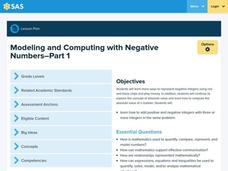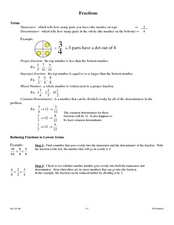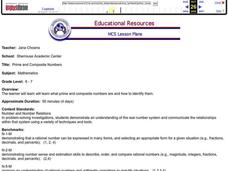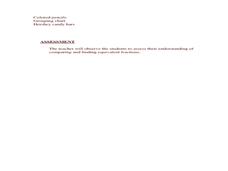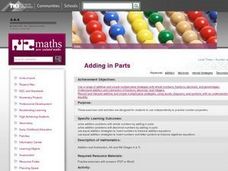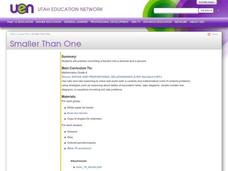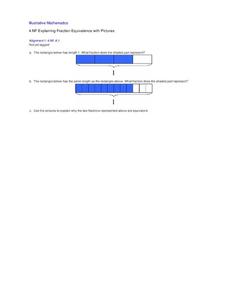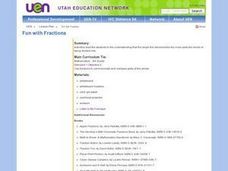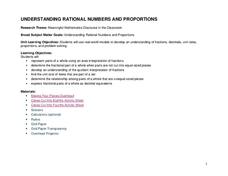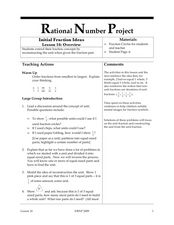Curated OER
Popcorn Fractions
Upper graders explore fractions to determine a fractional part of a whole. They are given 30 pieces of popcorn and asked to divide it into halves, thirds, etc. Learners practice representing the popcorn groups as a numerator and...
Curated OER
Dividing with Fractions
Use paper strips or models to relate division problems to division of fraction problems. Since the materials can be broken up, it helps them to show how they can complete repeated subtraction with fractions and not just whole numbers.
Rational Number Project
Initial Fraction Ideas Lesson 18: Overview
Develop young mathematicians' ability to compare fractions with investigation into the number 1/2. After brainstorming a list of fractions equivalent to 1/2, children identify a pattern in the numerators and...
Curated OER
Introduction to Equivalent Fractions
Explore equivalent fractions! Youngters measure the crown of their head with adding tape labeled with various fractions and fractional parts, and compare strips to notice numerical relationships. They fold adding tape in half and color...
Curated OER
Addition and Subtraction of Fractions
Young scholars demonstrate how to solve addition and subtraction of fractions. In this fractions lesson, students use folded paper to shade in fractional parts and identify the sum of the parts shaded.
Curated OER
Fractions Forever!
Middle schoolers identify proper, improper fractions, and mixed numbers. They reduce fractions to their lowest terms. They add and subtract fractions with different denominators, and multiply and divide fractions, as well as...
Curated OER
Prime and Composite Numbers
Prime and composite numbers are the focus of this mathematics instructional activity. In it, learners practice techniques for identifying these two types of numbers. They utilize the Inspiration program to complete a task that is clearly...
Curated OER
Hershey Bar Equivalent Fractions
Fourth and fifth graders explain how to use equivalent fractions. They recognize which fractions are equivalent. Pupils find equivalent fractions.
Illustrative Mathematics
Representing Half of a Circle
Geometric shapes make great visual models for introducing young mathematicians to the concept of fractions. Looking at a series of four circles, learners are asked to determine whether or not one half of each circle is shaded. To support...
Curated OER
Naming Fractions
Early learners investigate fractions and review the definitions of numerator and denominator on the chalkboard. They complete a "Naming Fractions" worksheet which is included in the lesson.
Curated OER
Adding in Parts
Third graders are able to split whole numbers into parts. They make numbers up to a tidy number. Students add and subtract tenths to make a decimals number into a whole number. They are able to add whole numbers up to three digits.
Curated OER
The Multiplier (small 2-digit by 1-digit numbers)
Second graders study digits in 2- or 3-digit whole numbers. They write and solve story problems which involve whole numbers, using addition, subtraction, multiplication, or division.
West Contra Costa Unified School District
Simplifying Fractions Activity
Warm-up pupils' fraction muscles with a four-question quiz, then delve into a learning game designed to reinforce the concept of simplifying fractions. Based on the "I do, We do, You do" method of teaching, the lesson directly...
Curated OER
Fractions
Students determine that a fraction is a part of a whole or part of a group. They write and read fractions and solve various fraction problems. They create their own fraction problem using colored candies for their classmate to solve.
Curated OER
Smaller Than One
Students examine how to convert fractions into decimals and percents. They work with base ten blocks and a worksheet to color in parts of 100 and renaming the parts as decimals and fractions.
Illustrative Mathematics
Making Hot Cocoa, Variation 1
Dividing with fractions can be a confusing task to some, but the activity illustrates how to make groups out of the problem and look at it visually. Use this problem with the lesson in the Additional Materials section to practice this...
Illustrative Mathematics
Explaining Fraction Equivalence with Picture
Visual models are a great tool for demonstrating the concept of equivalent fractions. Given two pictures, young mathematicians first identify each fraction and then write an explanation for why they are equivalent. Use as a guided...
Curated OER
New: Fun with Fractions
Third graders determine that the larger the denominator the more parts the whole is being divided into. They use fractions to communicate and compare parts of the whole. They discover what the numerator and denominator of a fraction...
Curated OER
Fractions - Equal or Not
A fabulous lesson on fractions awaits your young mathematicians. In it, learners are invited to explore the world of fractions by accessing websites that have educational activities and worksheets embedded in them. Some excellent,...
Curated OER
Fractions: Parts of a Set
Students identify, model, and label simple fractions. They describe and define them as equal parts of a whole, a region and a set. Students use words to describe fractions. They use manipulatives to explore the many different fractions.
Curated OER
Understanding Rational Numbers and Proportions
Learners explore parts of a whole. In this fraction lesson, students determine what makes a fair share. Working with manipulatives, learners solve mathematical problems containing fractions.
Curated OER
Technology Lesson Activity: Fractions
Fifth graders practice using the English measuring system by creating fractions. In this parts of a whole lesson, 5th graders combine math key bars to simulate small parts of a bigger item. Students combine the pieces to...
Curated OER
Problem Solvers
Fifth and sixth graders compare decimals to the place-value structure in the base-ten number system. They represent fractions as parts of unit wholes, as parts of a set, as locations on a number line, and as divisions of whole numbers....
Curated OER
Initial Fraction Ideas Lesson 16: Overview
Kids will compare creating fractions from pieces of paper to chips. They begin with a fractional part and work back to a whole. Then order fractions from smallest to largest. They also complete a worksheet to find the missing pieces to...

